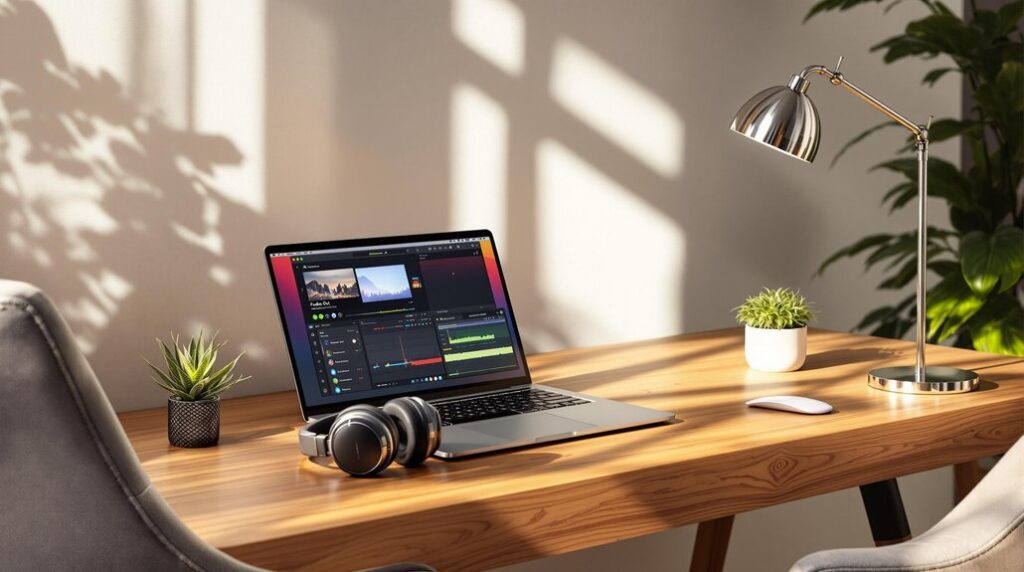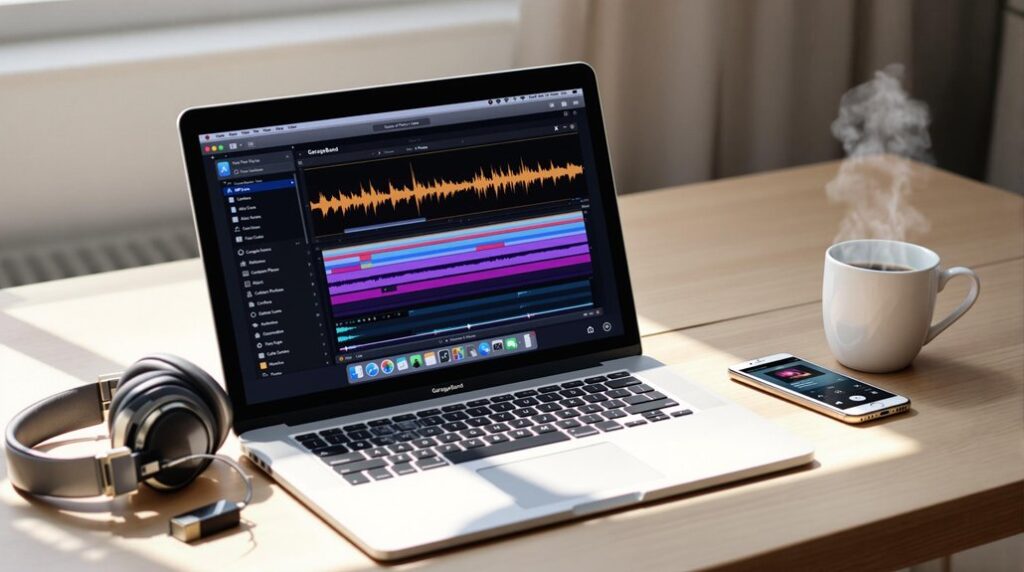Converting from GarageBand to MIDI requires precision and technical fluency. Start by preparing your GarageBand project—launch an empty project, select a software instrument, and create the desired MIDI region. Next, export your tracks as audio, choosing the appropriate file format while noting that MIDI files are not directly exportable. Finally, convert audio to MIDI using external tools, as GarageBand lacks this native functionality. Use the GB2MIDI script or employ "Drummer" tracks to facilitate conversion, enhancing your MIDI file ecosystem. The process, though intricate, enables broader creative experimentation when mastered fully. For a deeper understanding, explore further.
Key Takeaways
- Utilize the "Drummer" track feature in GarageBand to create MIDI-compatible drum tracks.
- Export your GarageBand project as an audio file using the "Export Song to Disk" option.
- Use the GB2MIDI Apple droplet script to convert audio files to MIDI format.
- Ensure your exported audio is high-quality for accurate MIDI conversion.
- Explore external software solutions for advanced audio to MIDI conversion tasks.
Prepare Your GarageBand Project
When starting on the task of converting your GarageBand project to MIDI, it is imperative to meticulously prepare your workspace to guarantee seamless execution.
Begin by launching GarageBand and opting for an "Empty Project" via File > New (⌘N). Select "Software Instrument" from the Track Type Menu to facilitate the creation of MIDI regions.
In the workspace, right-click to create an "Empty MIDI Region," ensuring its length spans the desired measures for your composition. By double-clicking the MIDI region, the MIDI Region View is activated, allowing precise input and modification of notes.
Familiarize yourself with the Smart Controls on the Toolbar, as they allow for real-time sound quality improvements and adjustments, which can be beneficial during the MIDI composition process. It is advisable to disable the Metronome and Counting functions to maintain an uncluttered workspace, fostering an environment conducive to effective MIDI composition and project management.
Export Tracks as Audio Files
To efficiently export tracks as audio files in GarageBand, navigate to the "Share" menu and select "Export Song to Disk," ensuring a streamlined integration with other digital audio workstations (DAWs) or collaborative environments. Begin by selecting the track or region to be exported, then open the export dialog. Here, choose the desired audio file format—WAV, AIFF, or MP3—and adjust the quality settings accordingly. This step is essential for audio rendering, as it determines the fidelity of your exported track. Adjusting the selection range within the timeline allows for exporting the entire project or specific sections, offering flexibility in your workflow. Note that exporting tracks as audio files does not produce MIDI files; it focuses exclusively on audio exportation. Ensure that audio file formats are compatible with GarageBand to prevent import issues and enhance the production workflow.
Convert Audio to MIDI
Converting audio to MIDI in GarageBand presents a unique challenge due to its lack of native support for this function. Users seeking to convert audio to MIDI files must employ alternative techniques, often described as a workaround or hack. One effective method involves utilizing the "Drummer" track feature to create drum tracks, which can be exported as external MIDI data. Additionally, the GB2MIDI Apple droplet script provides a viable solution for converting audio to MIDI, enhancing MIDI-Export capabilities from GarageBand. Exploring Drummer Selection in GarageBand allows users to experiment with various drummers and styles, offering a range of presets that can be adapted for MIDI conversion. – Drummer Track Utilization: Create patterns in GarageBand for export as MIDI files. – GB2MIDI Script: Facilitates conversion of audio files into MIDI-compatible formats. – Sound Recorder Track: Capture audio to convert using supplementary software. These methods extend creative possibilities beyond GarageBand's inherent limitations.
Frequently Asked Questions
How to Convert Garageband to MIDI File?
Converting GarageBand projects to MIDI file formats involves utilizing GarageBand features for audio editing and music production. Employ virtual instruments, MIDI controllers, and digital audio tools to guarantee software compatibility, facilitating music composition and sound design across diverse platforms.
How to Do MIDI in Garageband?
To create MIDI in GarageBand, utilize its robust features for MIDI editing and music composition. Leverage digital audio tools, MIDI instruments, and controllers for sound design, beat making, and arranging audio tracks, enhancing your music production capabilities.
How Do You Make a MIDI File?
To create a MIDI file, utilize MIDI composition techniques and MIDI sequencing basics. Select appropriate MIDI instrument configurations, employ MIDI programming tips, and optimize your MIDI workflow with suitable MIDI editing software. Understand MIDI file formats for conversion and performance.
How Do You Transpose MIDI in Garageband?
To transpose MIDI in GarageBand, utilize MIDI transposition techniques by accessing the "Transpose" function via GarageBand shortcuts. Adjust pitch shifting through music theory basics, and refine your project with MIDI editing tips, quantizing rhythms, and exporting tracks.
Conclusion
The process of converting GarageBand projects to MIDI involves meticulous preparation and execution. Initially, the project must be organized for ideal audio quality. Subsequent exportation of individual tracks as audio files is essential for maintaining the integrity of the original composition. Finally, employing specialized software or tools to convert these audio files into MIDI format allows for enhanced flexibility and further editing capabilities. Mastery of these steps facilitates seamless integration into diverse digital audio workstations for advanced music production.




